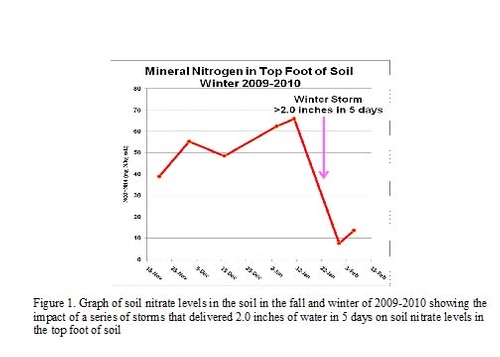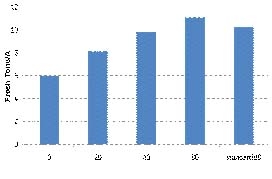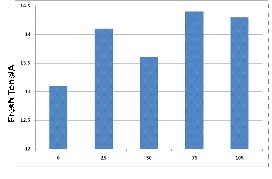The lack of rain in the Salinas Valley brings many concerns. The lack of runoff into lakes San Antonio and Nacimiento of course is a concern for the availability of water to run down the river to recharge the ground water for irrigation purposes. In addition, the lack of rain will affect the levels of salts that remain up in the root zone of the crops. Soil nitrate (NO3-) is one of the anions that will remain in the soil if leaching by winter rains does not occur. Nitrate is highly mobile and can be easily leached with just one or more significant rain storms; figure 1 illustrates nitrate leached from the top foot of soil by a series of storms that delivered 2.0 inches of water over the course of one week in the winter of 2010. High residual soil nitrates may come from several sources: 1) unused fertilizer from the previous crops or fall preplant nitrogen applications; 2) mineralization of crop residues from the previous crop; and 3) mineralization of soil organic matter over the winter (mineralization of soil organic matter is much slower during the winter but will still occur to a minimal degree).
We recently surveyed several soils looking for a site to conduct a fertilizer trial and observed that residual soil nitrate levels were routinely over 20 ppm nitrate-nitrogen. These levels were in contrast with levels that we observed last year following a wet spring where, in general, residual soil nitrate levels were in the 5 – 10 ppm nitrate-nitrogen range. The difference in conditions between a dry winter like this and a wet winter like last year is that it has implications for planning nitrogen fertilizer programs; with soil residual nitrate levels this high, the nitrogen fertilizer needs of the first crop fields will behave like second crop fields in that the robust amounts of residual soil nitrate in the soil that can provide for the crop needs and allow you to reduce nitrogen fertilizer programs.
To illustrate this point, we observed a great difference in the fertilizer needs of first vs second crop spinach during the 2011 growing season. In a first crop spinach planting, residual soil nitrate levels were at 5 ppm at the beginning of the trial. Spinach responded to at-planting applications of nitrogen up to 40 lbs nitrogen/A (Figure 2). The second crop spinach planting had initial levels of residual soil nitrate of 28 ppm nitrate-nitrogen which allowed the grower to skip the at-planting nitrogen application; he made one top-dress nitrogen application two weeks after planting to bring the crop to harvest. The results of a top-dress nitrogen evaluation indicated that there was no improvement in yield beyond 25 lbs nitrogen per acre (Figure 3).
These results indicate the importance of deep percolation of water on residual levels of soil nitrate. Winter rains have the beneficial effect of leaching salts from the soil. It is very unfortunate that nitrate is one of the salts that is leached with the water, but that is the case. In many of the discussions that we have had over the last several years regarding managing nitrogen fertilization more efficiently, we have emphasized that testing for residual soil nitrate is generally most effective for the second crop of the season. However, given the extreme lack of leaching rain events this winter, residual soil nitrate levels are also high at the beginning of the first crop in many areas in the valley and can be taken into consideration when planning nitrogen fertilization.

Figure 2. Yield response of first crop spinach under five
application rates of at-planting nitrogen (0 – 80 lbs N/A)

Figure 3. Yield response of second crop spinach under five application rates of top-dressed nitrogen (0 – 105 lbs N/A); no at-planting nitrogen was applied to this planting.